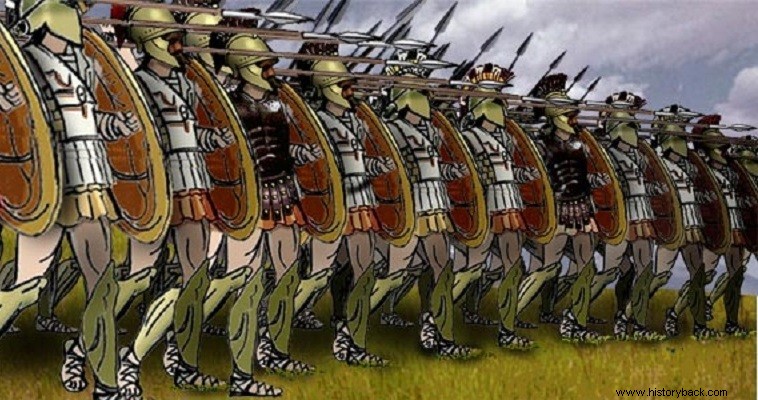
Agathoklis is one of the most impressive personalities of ancient Greek history. A true adventurer, he managed to rise from a mercenary soldier in the Syracuse army to become emperor, leader of the strongest Greek city in Italy, Syracuse.
From 312 BC the Syracuses were fighting against the mighty Carthage. After a series of maneuvers, Agathoklis found himself besieged in Syracuse by very strong forces of his opponents. In 310 BC Blocked from everywhere, without allies, he decided to try the impossible. Since the Carthaginians were threatening his city why should he not threaten theirs.
Immediately after taking this bold decision, Agathoklis began preparations for its implementation. He gathered 13,500 men and 60 ships and after leaving his brother Andandros, head of a strong guard, to defend the city he set out for the North African coast.
Taking advantage of the relaxation of the Carthaginian naval blockade, his fleet left Syracuse harbor and headed north to mislead the enemy as to his intentions. The Carthaginian ships pursued the Greeks around the northern and western coasts of Sicily, but to no avail. Seven days later the Greeks sighted the African coast.
The Carthaginian ships pursuing the Greek fleet finally caught up with it before the expeditionary force landed. However, in the conflict that followed, the Greek fleet prevailed and thus the disembarkation of the army took place normally. Immediately after, Agathocles took another daring action, he set fire to his ships.
He made this move not only to make it clear to his men that they had to either win or die there, but also why, if he did not burn the ships, he would have to allocate large forces to guard them. But no man was left out, they were all necessary to cause the distraction.
Immediately after landing his forces in Africa, Agathocles attacked and plundered all the Carthaginian territory, except for the heavily fortified Carthage. The citizens of the latter were even so panicked by the appearance of the Greek army in their lands, that they thought of coming to negotiations with Agathoklis.
They believed that in order for the Greek army to have arrived there, their expeditionary force in Sicily would have been annihilated. But Carthaginian ships from Sicily arrived in the city and the truth was learned. The panic of the Carthaginians then turned into rage against the insolent Greek, who dared to challenge their omnipotence.
A formidable army of 30,000 infantry and cavalry, reinforced by 2,000 quadrupeds of heavy war chariots, was immediately assembled under the orders of Vomilkas and Annon. This army moved against the Greek forces, which were waiting for it in the narrow plain of Tynita (only 2.4 km long).
The Carthaginian generals ordered their numerous heavy chariots to the front line with which they aspired to break the Greek phalanx. Next to the chariots lined up the elite heavy Carthaginian cavalry - about 1,000 men. Behind the horsemen lined up the infantry, with their elite "Holy Company" on the far right, under Annanos himself.
Facing these forces, the Greek army was deployed as follows:on the far left, opposite the "Holy Mountain", Agathocles lined up with 1,000 elite hoplites, in the center lined up 6,000 Greeks, but also Italian and Celtic mercenaries, with 3,500 Syracusan hoplites on their right . The far right was formed by 2,000 mercenaries.
About 500 other lancers, spearmen, archers and slingers, lined up in a formation of acrobols in front of the front of the army. Because Agathocles' men were not sufficient to cover the whole front, sailors of the fleet, armed with shields and shafts of spears, were placed to cover the gap in the Greek line.
The Carthaginians attacked first. Their chariots charged against the Greeks, raising clouds of dust. Their crews emitted horrendous war cries as they brandished their javelins menacingly. However, the Greeks were not daunted by the sight. With surprising composure they prepared to face the enemy tanks. As the chariots approached they began to receive a shower of missiles from the Greek archers.
Those of them that overcame the Greek barrier with relative success were neutralized by the Greek and mercenary heavy infantry. Many chariots, their crews neutralized and their horses wounded, turned back and fell upon the friendly array. This is exactly what Agathoklis expected. Seeing the enemy infantry mixing with the tanks and cavalry, he ordered his army to attack.
In a few minutes the proud barbarian army was gone. Only the "Holy League" resisted for a while, despite the death of their leader Annon. Soon it was all over and only the dusty corpses of the opponents remained on the bloody ground. The victory of the Greeks was overwhelming. At the same time, in Sicily, Amilkas Gisconas was attempting a general attack against Syracuse with 125,000 men.
In fact, according to his soothsayers, after the attack the Carthaginian general would dine in Syracuse. The Greeks, however, set an ambush on the numerous enemy army and destroyed it in one night, on the heights of Epipoli. Amilkas was taken prisoner and according to the oracle he received his -last- meal in Syracuse! The war with the Carthaginians continued until 305 BC. with various variations.
Agathocles did not manage to maintain his African conquests. But he managed to bring under his authority the largest part of Sicily, limiting the Carthaginians to the western end of the island and making his city the strongest power in the region. When he died, in 289 BC. Syracuse had an army of 30,000 infantry and 3,000 cavalry and a fleet of 200 warships.
